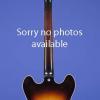Rare Late Seventies Antigua Stratocaster
This rare late 1970s Antigua Stratocaster weighs just 8.20 lbs. and has a nut width of just under 1 5/8 inches and a scale length of 25 1/2 inches. Solid ash body, one-piece fretted maple neck with 21 frets and black dot position markers. Large headstock with decal with "Fender" logo in black with gold trim, "SERIAL NUMBER S916756" in black beneath it, "STRATOCASTER" in black beside it, and "MADE IN USA" in black beneath "STRATOCASTER." Individual Fender "F" closed-back tuners with octagonal metal buttons. Two "butterfly" string trees with one nylon spacer. Three-bolt neck plate with the Fender backward "F" logo but without the serial number at the top. The neck is dated "09030293" (Wednesday, January 19, 1979). The neck pocket has an ink stamp "Gonzales" and a pencil marking "9B." There is also an inspection tag on the back of the neck: "1. D. Osborn; 2. D. Hattula; 3. J. Mora; 4. A. Hernandez; 5. N. Leon; 6. E. Leon; 7. R. Gove." Three black plastic Stratocaster pickups with balanced outputs of 5.58k, 5.60k, and 5.80k. Four-layer (Antigua/black /white/black) plastic pickguard. Three controls (one volume, two tone) plus five-way selector switch, all on pickguard. Black plastic ribbed-sided knobs with white lettering. Fender "Synchronized Tremolo" combined bridge/tailpiece. This guitar is in exceptionally fine (9.00) condition. There are two areas of surface wear, one on the back of the guitar by the neck and the other on the lower bass bout, where the Antigua finish has rubbed away so that the white undercoating shows. There is also a little bit of playing wear on the treble edge of the fretboard. This guitar is exceptionally light (late Strats are very heavy). Housed in the original Fender black hardshell case with black plush lining (8.75).
"The Stratocaster was launched during 1954 [and was priced at $249.50, or $229.50 without vibrato]. Samples around May and June were followed by the first proper production run in October. The new Fender guitar was the first solidbody electric with three pickups [Gibson's electric-acoustic ES-5, introduced five years earlier, had been the overall first], meaning a range of fresh tones, and featured a new-design vibrato unit that provided pitch-bending and shimmering chordal effects. The new vibrato -- erroneously called a 'tremolo' by Fender and many others since -- was troublesome in development. But the result was the first self-contained vibrato unit: an adjustable bridge, a tailpiece, and a vibrato system, all in one. It wasn't a simple mechanism for the time, but a reasonably effective one...Fender's new vibrato had six bridge-pieces, one for each string, adjustable for height and length, which meant that the feel of the strings could be personalized and the guitar made more in tune with itself...The Strat came with a radically sleek, solid body, based on the outline of the 1951 Fender Precision Bass. Some musicians had complained to Fender that the sharp edge of the Telecaster's body was uncomfortable...so the Strat's body was contoured for the player's comfort. Also, it was finished in a yellow-to-black sunburst finish. Even the jack socket mounting was new, recessed in a stylish plate on the body face...the Fender Stratocaster looked like no other guitar around [and in some ways seemed to owe more to the contemporary automobile design than traditional guitar forms], especially the flowing, sensual curves of that beautifully proportioned, timeless body. The Stratocaster's new-style pickguard complemented the lines perfectly, and the overall impression was of a guitar where all the components ideally suited one another. The Fender Stratocaster has since become the most popular, the most copied, the most desired, and very probably the most played solid electric guitar ever" (Tony Bacon, 50 Years of Fender, p. 18).
Translate:

